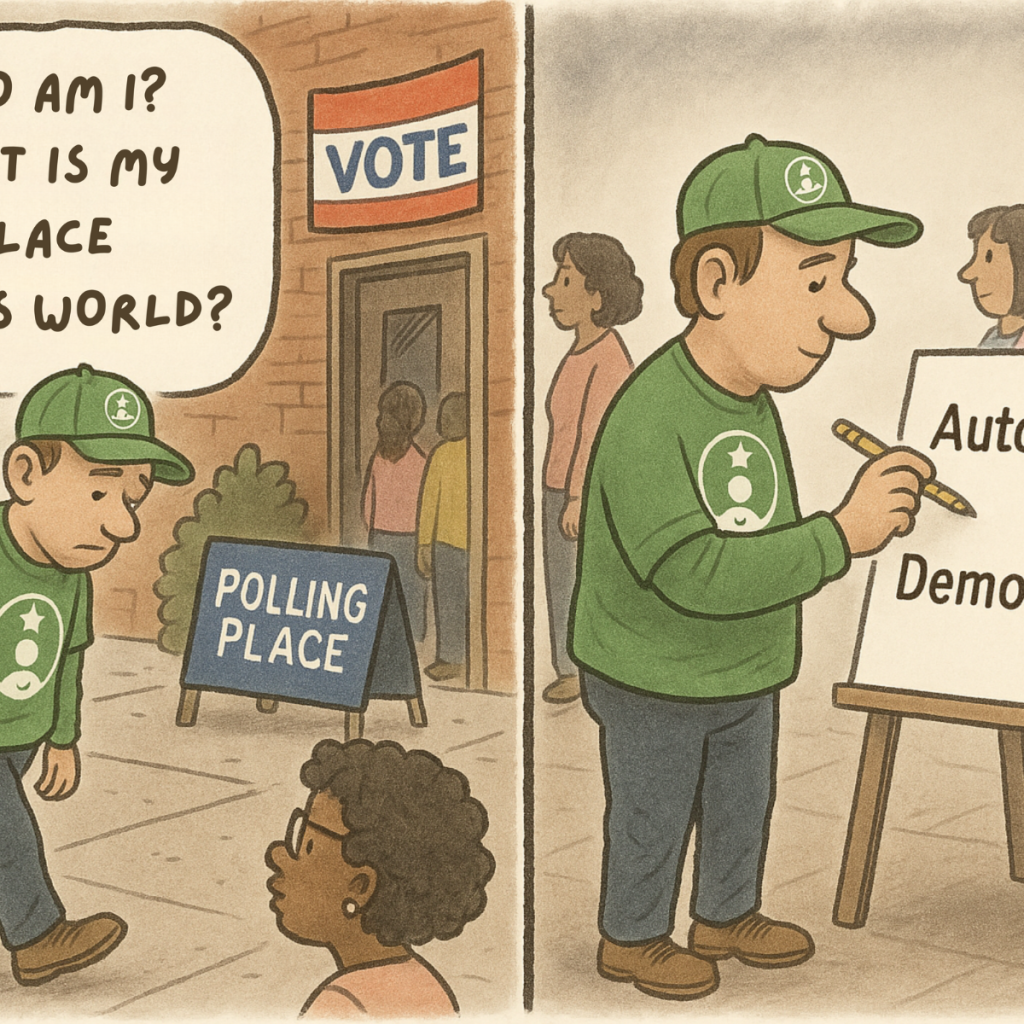Submission 2025
| Submitted by: | Kathryn Kincaid |
| Department: | Psychology |
| Faculty: | Arts |
My research examines the psychological roots of support for autocratic leaders. This image, styled as a political cartoon, illustrates a central finding from my research.
Through longitudinal and experimental studies, I have found that individuals who feel uncertain about their identity, future, or place in the world are more likely to support autocratic leaders — especially when they define themselves through a single, dominant group identity. In contrast, individuals with more complex self-concepts — people who identify with and define themselves based on multiple, diverse identities (e.g., researcher, parent, runner, member of a faith community) — are less likely to support autocratic leaders when they experience uncertainty.
The image depicts this psychological process. A voter who is burdened with uncertainty approaches a polling place. Their matching hat and shirt feature the same logo, symbolizing that the individual defines themselves in terms of a single, dominant identity. In the background, others wear varied colors, symbolizing more complex identities. As uncertainty and a simple, singular identity converge, the voter casts a ballot leaning towards autocracy.
Was your image created using Generative AI?
Yes.
Did you upload any materials into an AI tool to help generate your image?
No.
Which model of generative AI did you use?
DALL-E 2 by OpenAI.
How was your image created?
This image was planned and sketched using pencil and paper, produced using ChatGPT’s image generation feature, and iteratively refined using a combination of ChatGPT and Canvas image editing tools.
To begin, I used pencil and paper to plan out the political cartoon I wanted to create. In this sketch, I purposefully chose and designed specific elements to represent each of the abstract psychological concepts from my research.
I then wrote a detailed description of the desired image, listing each of the specific features to be included. To generate the initial image, I provided ChatGPT this description as well as instructions to echo the aesthetic of traditional editorial cartoons that offer commentary on pressing social and political issues. I carried out several rounds of revision via ChatGPT to adjust the image’s style and ensure an accurate representation of my research findings.
Finally, I used Canva image editing software to make more precise, controlled revisions to the image, such as altering the specific text that appeared in the thought bubble and resolving minor inconsistencies in the voter’s appearance between the two panels.
How did you craft your prompt to guide the generative AI in creating your image? Please describe the technique or approach you used to convey your vision to the AI.
I began by sketching a draft of the visual elements I wanted to use to depict the abstract psychological concepts from my research. Because my hand-drawing skills were limited, I used AI to bring this vision to life.
I provided detailed prompts to the AI, such as “The left panel should show a voter entering a polling place, with a thought bubble above their head that says “Who am I? What is my place in this world?” The right panel…should show the text on the ballot. The two options on the ballot should be either autocracy or democracy. The voter should have their pencil hovering over autocracy.” Stylistically, I drew inspiration from editorial cartoons that offer critiques of socio-political issues: I prompted the AI to use simple lines and muted colors.
I ran many rounds of revision, requesting specific changes to details like the voter’s expression, the clarity of the ballot options, and the distinctiveness of the background characters’ clothing. Finally, because fine-tuned changes (e.g., precise text editing) were difficult to implement with AI, I later used Canva image editing tools to make more precise edits that ensured the final image accurately reflected my research.
Where is the image located?
This conceptual illustration visualizes findings from one longitudinal study conducted with 8,280 American voters and two experimental studies I conducted with 998 University of Alberta student participants. In the longitudinal study, uncertainty and the desire for a strong, non-democratic leader were measured over time. In the experimental studies, participants were primed to experience either high or low uncertainty and then primed to reflect on the ways their identity is either simple or complex. As the dependent variable, I then measured participants’ level of support for an autocratic leader.

